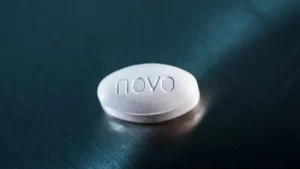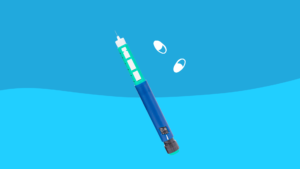Trulicity Active Ingredient: Dulaglutide Injection Dosage, Warnings
HOME | DIABETES EDUCATION | TRULICITY ACTIVE INGREDIENT: DULAGLUTIDE INJECTION DOSAGE, WARNINGS
Trulicity, also known as dulaglutide injection, is a medication for type 2 diabetes. The starting dose is usually 0.75 mg per week, but it can go up to 4.5 mg.
When switching diabetes drugs, adjust doses with care. Certain drug interactions require caution.
Common side effects include nausea, which can be controlled with changes in diet. While Trulicity can help control blood sugar levels, it may also lead to serious risks like pancreatitis or thyroid tumors.
More information on dosages, warnings, and effectiveness is available.
Key Takeaways
- Trulicity’s active ingredient is dulaglutide
- Dosage ranges from 0.75 mg to 4.5 mg weekly
- Caution is needed when starting or stopping other diabetes drugs
- Be wary of specific drug interactions
- Monitor blood sugar levels regularly for safety
Trulicity Overview
Trulicity, with its active ingredient dulaglutide, is an effective medication for adults with type 2 diabetes. As a GLP-1 receptor agonist, dulaglutide in Trulicity lowers blood sugar levels, aiding in diabetes management. It also reduces the risk of major heart problems for people with type 2 diabetes.
The usual starting dose of Trulicity is 0.75 mg once a week, but your doctor can adjust this based on your body’s reaction. With a weekly injection of Trulicity, managing your diabetes can become easier. Consider Trulicity as a potential ally in your fight against diabetes.
Dosage Information
Trulicity, used for type 2 diabetes, has starting dosages from 0.75 mg to 4.5 mg, given once a week. This is the same for both adults and kids. Here’s what you need to know about Trulicity’s use:
Dosage Choices: Trulicity offers weekly dosages from 0.75 mg to 4.5 mg.
Changes with Diabetes Medications: You may need to change the dose when starting or stopping other diabetes drugs.
Mixing with Other Drugs: Be careful when using Trulicity with drugs like acarbose, alogliptin, and canagliflozin. They can boost effects.
Combining Specific Drugs: Using Trulicity with carbamazepine or clonidine needs careful checkups to avoid harmful reactions.
How to Use: Follow the steps for injection. Change the injection spot regularly and keep an eye on your blood sugar levels.
Common Side Effects
Nausea is a common side effect for Trulicity users, affecting 8% to 29% of people. This usually starts 2 to 3 days after starting Trulicity and often goes away after a few weeks. Increasing your Trulicity dosage can cause more nausea. However, less than 2% of users stop taking Trulicity because of this.
To ease nausea from Trulicity, try eating smaller meals, avoid fatty foods, and split your meals into smaller parts. This can help ease the discomfort. Remember, everyone is different, so find what works for you. Always watch for severe or unusual symptoms and tell your healthcare provider immediately. Stay informed and ask for help when needed.
Managing Nausea
If you’re taking Trulicity and feeling sick, change your eating habits. Here’s how:
- Have small meals often.
- Skip food that’s high in fat or grease.
- Try simple foods like toast, crackers, or rice.
- Drink a lot of water.
- Speak with your doctor if the sickness doesn’t go away or gets worse.
Serious Side Effects
Trulicity with dulaglutide may cause serious side effects like pancreatitis, hypoglycemia, kidney issues, allergic reactions, and thyroid tumors. Look out for thyroid cancer symptoms, especially if you’ve had this cancer before.
Signs of pancreatitis include severe stomach pain, nausea, and vomiting. Symptoms of low blood sugar include dizziness, sweating, and confusion.
Regular check-ups are necessary for early detection of kidney issues, allergies, or thyroid problems. Contact your doctor immediately if you notice anything unusual. Stay informed and proactive to handle these potential severe side effects.
Adverse Reactions
Trulicity treatment can cause stomach side effects, especially at the start. Here are some important facts:
Trulicity combined with insulin secretagogues can increase your chance of low blood sugar.
The occurrence of nausea and low blood sugar differs among various groups during clinical trials.
Serious stomach side effects might need kidney function checks.
People with a history of MTC or MEN 2 and severe stomach disease shouldn’t take Trulicity.
Keeping in touch with your doctor is crucial to handle any side effects effectively.
Prevalence of Nausea
Nausea is a common side effect of Trulicity, affecting 8% to 29% of users. This usually happens within the first 2 to 3 days of starting the medication. For most people, this nausea lessens after the first 2 weeks. But, increasing the dose can make the nausea worse.
Less than 2% of users stop using Trulicity because of nausea. To manage this, try eating smaller meals more often, avoiding fatty foods, and splitting your daily meals into smaller parts. This can lessen the nausea and help you continue using Trulicity for type 2 diabetes.
Incidence of Hypoglycemia
The use of Trulicity can lead to different rates of low blood sugar, also known as hypoglycemia. These rates can change based on the individual and the other medications they’re taking. For instance, pairing Trulicity with insulin secretagogues can heighten the risk of hypoglycemia. Patients must know the signs of low blood sugar so they can react quickly.
People should monitor their kidney function if they’ve severe stomach problems while taking Trulicity. Those with kidney problems should be cautious when beginning or upping their Trulicity dosage to avoid low blood sugar. Understanding these points can help you manage your Trulicity treatment and avoid low blood sugar incidents.
Important Safety Information
When using Trulicity, a once-a-week shot for type 2 diabetes, watch out for side effects. This drug has dulaglutide, which can cause low blood sugar (hypoglycemia), stomach troubles, and serious issues like thyroid tumors, pancreatitis, and allergies. Signs to look out for include dizziness, confusion, stomach pain, or severe allergic reactions. If you see these signs, get medical help right away.
Everyone reacts differently to drugs, so talk regularly with your doctor. If you’ve had kidney problems or specific thyroid cancers, use Trulicity carefully. Always be aware of changes or worries while using this drug.
Pharmacology Details
Dulaglutide, a GLP-1 receptor agonist, helps control type 2 diabetes. It stimulates insulin release, reduces glucagon secretion, and slows stomach emptying to better control blood sugar. Its half-life is about 4-5 days, allowing once-a-week dosing for lasting effects.
Besides lowering blood sugar, Dulaglutide also aids weight loss by reducing hunger and slowing stomach emptying. It’s been shown to lower the risk of serious heart problems in type 2 diabetes patients, showcasing its heart-protecting properties.
- Dulaglutide Mechanism: GLP-1 receptor agonist
- Blood Sugar Control: Lowers blood sugar
- Dosage Convenience: Dosed once a week
- Weight Management: Helps with weight loss
- Cardiovascular Benefits: Lowers risk of serious heart problems
Patient Handout
Here’s what you need to know about managing your type 2 diabetes with Trulicity:
| Trulicity Facts | How Often | Key Details |
|---|---|---|
| Contains dulaglutide | Once | GLP-1 receptor agonist |
| Given in injections | Once | Dosage is 0.75 mg to 4.5 mg weekly |
| Possible side effects | Once | May cause nausea, vomiting, diarrhea |
Trulicity is a weekly injection containing dulaglutide, used to control blood sugar levels in type 2 diabetes. The dosage varies between 0.75 mg and 4.5 mg, depending on your body’s response. If you’ve had certain thyroid cancers or serious stomach problems, be careful. You might feel sick, vomit, or have diarrhea but these side effects usually go away over time. Trulicity helps keep your blood sugar stable and lowers the chance of serious heart problems in adults with type 2 diabetes.
Formulary Information
Trulicity, a type 2 diabetes medication, contains the active ingredient dulaglutide. It’s a GLP-1 receptor agonist which can be given via a weekly subcutaneous injection to help control blood sugar levels.
Dose options include 0.75 mg, 1.5 mg, 3 mg, and 4.5 mg. Dulaglutide can reduce the risk of major cardiovascular events in patients with type 2 diabetes. However, users need to follow dosing instructions carefully and watch for potential side effects.
This information can guide decisions about including Trulicity in your formulary for managing type 2 diabetes.
Drug Effectiveness
Trulicity is a medication proven to help control blood sugar levels, as shown in clinical trials. It helps the body release insulin after eating. However, its effect can differ for each person. Therefore, you should talk to your doctor to see how Trulicity can help you.
Apart from controlling blood sugar, Trulicity also reduces the risk of heart problems in people with type 2 diabetes. This shows that Trulicity can manage diabetes and its complications.
Safety Summary
Trulicity can cause serious health issues such as thyroid tumors and pancreatitis. Here’s what you need to know:
Thyroid Health: Trulicity, which contains dulaglutide, might lead to thyroid tumors. Be careful.
Trulicity may cause tumors in the thyroid, including thyroid cancer. Watch for possible symptoms, such as a lump or swelling in the neck, trouble swallowing, hoarseness, or shortness of breath.
Signs of Trouble: Keep an eye out for signs of thyroid cancer while using Trulicity.
Past Health Issues: If you’ve had certain thyroid cancers before, don’t use Trulicity.
Blood Sugar Levels: Frequently check your blood sugar levels to make sure they’re in a safe zone.
Possible Serious Side Effects: Trulicity can cause pancreatitis, low blood sugar, kidney problems, severe allergies, and thyroid tumors.
Stay on the safe side and be aware of these possible side effects. If you spot any worrying signs, quickly get in touch with your doctor.
Frequently Asked Questions
Can Trulicity Be Used in Combination With Other Diabetes Medications?
Yes, Trulicity can be combined with other diabetes drugs. However, check with your doctor to figure out the right combination for your condition.
Are There Any Specific Dietary Restrictions or Recommendations While Taking Trulicity?
With Trulicity, eat balanced, small meals regularly. Steer clear of fatty foods and drink plenty of water to help with nausea, a common side effect. Contact your healthcare provider if you experience severe symptoms.
How Long Does It Typically Take to See Results From Trulicity in Managing Blood Sugar Levels?
Trulicity typically starts showing results in managing blood sugar levels after a few weeks. Be sure to stick to your treatment plan and regularly consult with your healthcare provider.
Can Trulicity Be Used in Patients With a History of Thyroid Issues or Pancreatitis?
Trulicity can be used by patients with thyroid problems or pancreatitis history. However, it’s important to tell your doctor about your medical past before starting. Keeping an eye out for any issues is important.
Are There Any Specific Monitoring Tests or Follow-Up Appointments Required While Taking Trulicity?
Regular follow-up appointments are crucial when taking Trulicity. These visits ensure your treatment is working and safe. It’s vital to keep up with these appointments.



